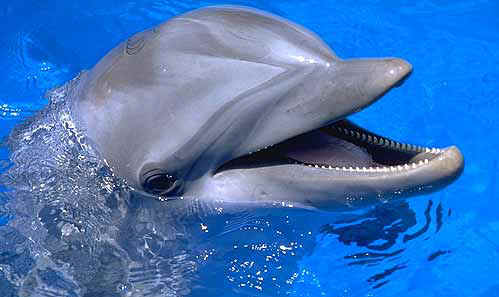| Created by Spencer W. |
DOLPHINS | |
| CLASSIFICATION
|

CLASSIFICATION
The average length of a dolphin is 8 to 9 feet long and males weigh up to 800 pounds while females weigh close to 600 pounds. SPECIAL FEATURES Dolphins are mammals but they live in the water. Since this is a problem they have when they need to breath they have a blow hole. This allows them to come to the surface of the water to take a breath without exposing their entire head. HABITAT DIET Dolphins eat approximately 4% to 5% of their body weight in food per day. A nursing mother's daily intake is considerably higher: about 8% REPRODUCTION Dolphins are most likely to mate during the spring, with a male-female courtship ritual playing a large part in dolphin dating. When copulating, the male dolphin nudges the female from behind with his sex organ for several minutes, and then mounts her from behind. After this, dolphin mating is roughly as ordinary as any other mammalian mating. Dolphins are among the most sexual of animals, and are
not monogamous. When aroused, a dolphin male may mate several times an
hour, often with the same female but not always. Even though, males
swim away and female dolphins usually depend on their pods to help
them protect the baby dolphin.
HUMAN IMPACT Dolphins, particularly coastal animals, are affected by heavy boat traffic, habitat destruction, and pollution. Industrial and agricultural pollutants in coastal habitats have resulted in high levels of toxins in the water and high concentrations of toxins in dolphin tissues. In the past, bottlenose dolphins have been taken directly for meat, leather, oil, and meal (for fertilizer and animal feed). Hunting still occurs in various parts of the world including Peru, Sri Lanka, Taiwan, and Japan. In the course of fishing operations, gear and nets can accidentally entangle and injure or drown dolphins. Dolphins that are injured or killed and discarded in the course of fishing operations are called bycatch. Experts have concluded that it's likely hundreds of thousands of marine mammals are killed as bycatch each year. The incidental capture of whales and dolphins in fishing gear is one of the most significant threats to some bottlenose dolphin populations. WEBLINKS http://www.dolphins-world.com/
SOURCES: http://www.earthtrust.org/wlcurric/dolphins.html http://www.follybeach.com/Dolphin-face.jpg http://www.buzzle.com/articles/dolphin-habitat-where-do-dolphins-live.html http://www.seaworld.org/infobooks/bottlenose/dietdol.html http://www.dolphins-world.com/
| |

